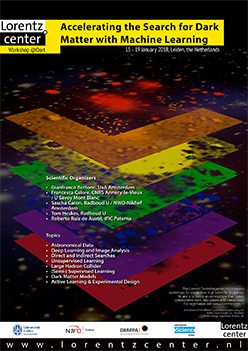Accelerating the Search for Dark Matter with Machine Learning
Lorentz Center@Oort
Organisers: Tom Heskes (Radboud University), Gianfranco Bertone (UvA), Francesca Calore (CNRS), Sascha Caron (Radboud University and Nikhef) and Roberto Ruiz de Austri (IFIC Valencia)
Contact: Nieke Tander (Lorentz Center), Sascha Caron
From Monday 15 January through Friday 19 January 2018
Lorentz Center@ Oort – Leiden, The Netherlands
Scientific Topic : In this workshop we aim to explore, and to encourage, the utilization of state-of-the-art machine learning algorithms for research in dark matter physics and astronomy. Our objective is to accelerate the identification of Dark Matter with a multidisciplinary approach: The researchers coming to this workshop bring together expertise in experimental and theoretical particle physics, astrophysics, astronomy, statistics and Machine Learning. The workshop is planned to be a Kickoff meeting to generate a new open research community. We plan a whitepaper, follow-up workshops, a webpage and a mailing list for the DM-ML community.
Workshop Format Lorentz Workshops@ Oort are scientific meetings for small groups of up to 60 participants, including both senior and junior scientists. Lorentz Center meetings dedicate a considerable amount of time to discussion sessions, thus stimulating an interactive atmosphere and encouraging collaborations between participants. This format typically generates extensive debates and enables significant progress to be made within the research topic of the meeting.
Registration by 15 October via:
Link to the Workshop webpage at the Lorentz Center
Lorentz Center Facilities The venue Lorentz Center@ Oort, located at the Faculty of Science campus of Leiden University, the Netherlands. www.lorentzcenter.nl.
